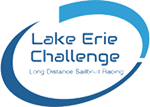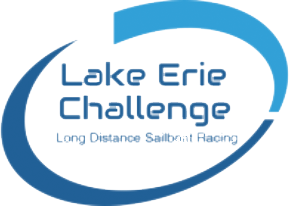- Lake Erie Challenge: Long Distance Sailboat Racing on Lake Erie

HOW TO TURN A GOOD CREW INTO A GREAT TEAM: THE SECRETS OF SAILING TRADECRAFT
June 2, 2021
LOOK FOR CLUES, NOT ANSWERS
June 2, 2021
This year’s Bayview Mackinac Race began like any other offshore race. The team, composed of Jim, Scott, Kate, Steve, Ryan, and me, stayed up way too late looking at wind forecasts and worrying about what we may have forgotten to pack. The next morning, we headed to the start of the race in matching neon green crew gear, unaware of what the next 48 hours would hold.
When we took off from the starting line in Port Huron, MI on Saturday afternoon, we had sunny skies, moderate breeze, and flat water–champagne sailing. The whole crew was thrilled to be back on the boat together, headed offshore, and off the grid. Later that afternoon, we found ourselves setting the code zero and leaving the boats around us in the dust. So far, so good. I had the pleasure of driving at sunset that night. We were headed almost due north, the sun lit up the sails with an orange glow, and the breeze was building. Everyone was buzzing with the excitement of our first night. The boat was so balanced, I only had to keep two fingers on the tiller to steer. Shortly after sunset, I went below for my first break.

I woke up around 1 am to a wave crashing so violently the whole boat rattled. I had been sleeping on the floor and was worried something had broken, but I quickly realized it was just the wind making a grand entrance. Already fully dressed in foulies, I shoved a Cliff bar and some Sour Patch Kids into my pocket, turned on my headlamp, and opened the hatch with a cheerful “Good morning, team!” As I found my spot on the rail that I would occupy for the next six hours, I tried to get my contacts to focus. The breeze had come up significantly since I had gone below for my break, and so had the waves. It was so dark that the forward person on the rail had to call out waves to the driver so we didn’t get swamped with every one. We were delirious, already low on sleep, and a few of us seasick. Some might call it miserable, but it was also incredible.
The moon rising was absolutely stunning and made the waves a little more defined in the dark abyss that is night sailing. The entire Milky Way was visible, and it was easy to spot satellites and shooting stars without even looking for them. We pushed our boat so hard in the tough conditions. And, in our own discomfort, we found a new and higher level of performance. We rotated drivers every hour to keep ourselves fresh on the tiller and active on mainsail trim. We constantly adjusted the jib to balance the boat and create more power in the waves, playing with trim, tweakers, and jib car positions.
Comet NEOWISE was prominent on the horizon until sunrise. As the sky slowly grew lighter with brilliant shades of pink, yellow, and orange, the warmth melted away the challenges the night had brought. We welcomed the return of our telltales, which had not been visible in the darkness. Suddenly the waves were easy to drive in since we could see each one towering off the port bow without straining our eyes in the dark. Kate and I fell asleep on the rail, huddled together just after sunrise, finally relieved of our wave watch duties. It was a good nap, but waves kept crashing through the ankles of my pants, and I dreamed of having on my dry boots that I left at home in an effort to bring less weight aboard.

On Sunday morning I had my second opportunity to drive. The waves were big, the breeze was moderate, and I plowed the bow into every other wave for the first five minutes of my shift. I spoke with Steve, the previous driver, to understand the adjustments that were working for him and how he was approaching each wave. As it turns out, his adjustments did not work for me. That morning I learned a very important lesson: Every driver is a little different, and, no matter your level of experience, it takes everyone time to find their groove. We discussed putting more power into the boat to get through the waves. I made a different set of adjustments that worked for me that also increased our boat speed by half a knot while holding the same angle. I gained several races worth of confidence in that one driving shift. In fact, I gained so much confidence that I volunteered to drive later in the day when it was blowing 17 knots and gusting to 22. I took the helm, and this time instead of smacking into every other wave, I hit every single one. But as before, after about five or ten minutes, I found my groove, and we took off. We had just tacked onto starboard and were heading west, back towards the Michigan coast. The waves seemed to grow larger and steeper since they had miles of fetch to reach us in the middle of Lake Huron.
Morale was high on Sunday. We were hanging with our competitors, the boat was performing well in the rough conditions, and in the sunshine it’s not quite so miserable to be soaking wet all day. It had been rough, though, and no one had eaten much. We decided to get the whole crew on deck for a family dinner before the next group went down for a break. Scott proudly handed each crew member half a chicken. I was on the rail sandwiched between Kate and Ryan when we received our dinner. We all looked at the slimy hunk of meat in our hands, then looked at each other, and laughed that we had never had a dinner like this before. We got grease all over our hands and faces, but it didn’t matter. All we had to do was wait for another wave to crash over the bow and we were as clean as ever. Ryan told us his chicken was still partly frozen, but a wave had thawed it out for him. At sunset, we broke out the Oreos and toasted to the team and the epic race we were having so far. We executed a flawless headsail change just after sunset. The J/88 has only one jib halyard, so we had to sail bareheaded for a minute, but we recovered quickly.

As the horizon grew dark, the chicken didn’t feel so great in our stomachs anymore. The waves were just as large as they had been all day, and the boat was bobbing and pitching like a cork trying to stay afloat in a washing machine. We were sailing closer to the coast line, and that provided a bit of relief from the chop, though not much. To top it off, there had been a problem with the holding tank and the bilge; it smelled terrible inside the boat. We knew it would be a sleep-on-the-rail kind of night again. Now that we had been soaking wet for about 36 hours, we were all chilled to the bone. Whoever wasn’t driving huddled together on the rail like penguins to keep warm.
One of the last people I spoke to in Port Huron before leaving for the start of the race was my Quantum colleague, Wally Cross. He smiled and said “200 miles of hiking, Katy!” That phrase didn’t fully register in my mind until around 4 am on Monday morning. I was trying not to think about the wall of water crashing over us as I buried my head into my knees to keep my face dry. Someone once told me that everyone has their “frequency” with seasickness−everyone has a set of conditions that can make their stomach twist. I was also trying not to think about that. But I kept asking myself, “Is this my frequency?” We had been on the rail hiking for over 160 miles, and that meant roughly 40 miles to go.
Thankfully, I did not find my frequency Monday morning, I was even able to get about two hours of sleep. My uncanny ability to nap anywhere at any time always seems to come in handy during offshore races. Dawn once again brought visibility, which is truly your best friend offshore. Since I was able to get a bit of sleep, I rotated onto the tiller for the two hours before sunrise. Driving out of the dark is one of the most beautiful and spectacular things about offshore sailing. No matter how exhausted you may be, you can’t help but feel energized as you watch the lake come to life, see the definition in the shoreline return, and see those magical telltales dancing on the headsail once again. This was the morning of the finish, and our closest competitor was now in sight. We had been reeling them in all night with a hunger to beat them to Mackinac Island. We continued to push Legacy’s limits, making quite a few tacks up the shoreline. We knew our competitor owed us at least a few hours of time, so as long as we could see them finish, we should be able to correct ahead.

The last stretch of the race was the hardest, trying to stay focused and remember the race is a marathon, not a sprint. When we finally made it into the Straits of Mackinac, we knew we just needed to keep moving. The island greeted us with a stellar view of the Grand Hotel and relief from the waves. Legacy flew through the flat water and charged on toward the finish at Round Island Lighthouse. We encountered Puffin, a boat that was not in our class, near the finish line. And what do competitive sailors do when they meet with another boat? Match race of course! From that moment on, it was an unspoken goal of the whole team to beat Puffin to the finish line. The entire crew was on the rail hiking the boat down for our lives, executing clean maneuvers exactly when it counted, and tactically trying to out-sail the other boat. Even though our bodies were sore and it got harder to cross the boat with each tack, we pushed past the finish line.

We finished 50th in line honors, and Puffin finished 51st. We beat our competitor who owed us time, placing us in 3rd in Division IV and 3rd in Class L. Three generations of the Sorbie family, Jim (grandpa), Scott (son), and Kate (granddaughter), completed the race together. Old friends came together, Kate finished her first offshore race, Ryan and I sailed our first Bayview Mac, and Scott, Jim, and Steve couldn’t even keep track of how many Bayview Macs they had finished. When we crossed the finish line, we had become one team that tackled this adventure head on and came together to grow our knowledge and experience. It was an honor to be aboard Legacy for the 2020 Bayview Mackinac race, and I look forward to more sailing with this team in the future.
To those who are interested in offshore sailing, do it! If you’re entering your own boat for the first time, start with a short race – something close to 24 hours. In the Great Lakes, the Hook Race and the Queen’s Cup are great events if you want to dip your toe into offshore sailing. If you’re crew looking for a boat to sail with, try to find a group that has some experience for your first race. Cruisers, pick a new place to sail to. Do your research, get adventurous, and get out there!


